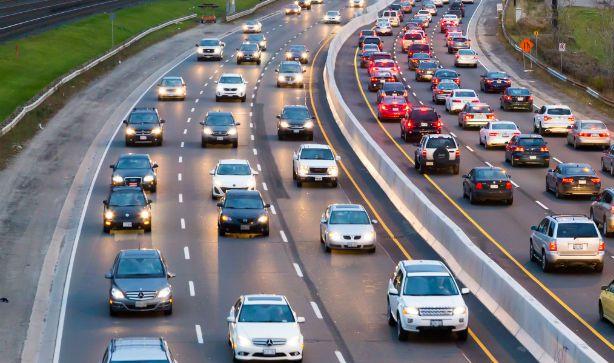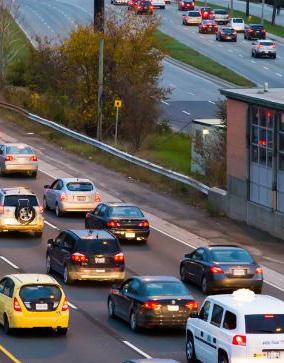
9 minute read
Living in Car-Centric Societies
Historically, as cities grew the need to organize urban zones became more
important. Segregating industrial sectors, green areas, private space, and others, grew in prominence (Miralles-Guasch,
Advertisement
2006, p.49). In order to move throughout
the zones, public spaces turned into the
roads that connected them (Miralles-
Guasch). This has encouraged the use of cars by making it a necessary means of travel for many people living in and around cities. They are convenient, stylish and comfortable. It is easy to understand why many cities in North America are designed primarily around the movement of cars (Miralles-Guasch). The director
of the Center for Public History at the University of Houston wrote that “one half of a modern American city’s land area is
dedicated to streets and roads, parking lots, service stations, driveways, signals and traffic signs, automobile-oriented businesses, car dealerships, and more” (Frazer, 2019). Automotive cities result in
less built infrastructure for other methods of transportation such as buses, bike lanes and streetcars.
16
Figure 1.1 Traffic in Toronto, Ontario (mikeinlondon, 2018).

Automobiles gained popularity in the 1920s when the post-war construction of
cities was prioritizing suburbanization and
practicality (Miralles-Guasch, 2006, p. 49).
The development of road infrastructure allowed for fast and convenient transportation with private vehicles (Miralles-Guasch). Over some decades,
it was clear there were many negative implications of driving a personal vehicle. These included the fumes and pollution that cars emit, traffic that causes delays and high-risk accidents (Smith, 2013). Yet,
many people still prefer the convenience
17
of having their own personal vehicle. The popularity of private transportation leads to a lack of interest in public transportation options.
Car-centric societies are an issue for gender-equitable resources because women do not have equal access to private transit in comparison to men. When looking at private transit through a
gendered lens, you would see that it is men who have greater access to convenient methods of transportation (Turner and
Grieco, 2006, p.53). This consequence is a result of socially assigned gender roles and a division of labour (Turner and
Grieco). Statistically, women earn less than men and perform 75% of the world’s
unpaid caregiving work (Criado-Perez,
2019, p.30). Care work is the unpaid
labour that adults do for children and other reliant people (Madariaga, 2013, p.33). Of
course, one can argue that men perform caregiving roles as well. However, men do not have the same societal limitations and upbringing that women have. This places the expectation of women behaving and performing the caregiving duties in a household. Eva Kail, a member of the City of Vienna’s Urban Planning Department
said it best:
You can’t influence the share of unpaid work by architecture, but you can support it. We would hope it “ would support 50% of men as well – but statistics show it is still more women doing that work” (Hunt, 2019).
Due to the amount of time in the day that women are carrying out their unpaid caregiving roles, they are less likely to have or maintain a full-time job (Criado-
Perez, 2019). The difference in income
means women are less likely to be the ones using the private vehicle in a household and rely on public transportation for travel.
Since women earn less income than men, they cannot always afford the cost of a vehicle. In the United States, a Michigan based study collected data on the gender wage gap. Throughout the 1980’s the
female to male ratio of income was roughly 60%; and “by 2014, women full-time
workers earned about 79% of what men
did on an annual basis and about 83% on
a weekly basis” (Blau and Kahn, 2017).
Therefore, women do not have the same access as men do in regards to funds that could afford a car. With less income,
women are forced to use the less reliable and unsafe methods of public transit. Although many women are forced into using public transit due to lack of time and income, transit systems are not designed for their specific needs (Turner
and Grieco, 2006, p.53). The main difference between men and women in transportation is the gendered division of labour (Madariaga, 2013, p.41). Public
transit performs exceedingly better when the user is making a single purpose trip, such as for employment purposes (Criado-Perez, 2019). Multi-purpose trips
are often performed by care workers;
these include dropping off the children at school, going to the grocery store or helping an elderly relative (Madariaga,
p.33). Public transit does not perform well with multi-purpose trips, since planning policies prioritize the development of
transit connections for economic activity and working spaces, rather than care work services (Madariaga). This is due
to studies categorizing care work as
leisure activities since it includes activities such as shopping, escorting or strolling (Madariaga). This is a problem because
these multi-purpose caregiving trips are mandatory for many households, yet transport planners are not providing proper connections and accessibility of these essential services.
This is a gendered issue because women are the dominant gender that trip chains
18
these trips account for a slightly larger percent of all trips (10.5 percent of the trips made on home-to-home tours, for instance, versus 7 percent of all trips) than in the general population and show visible Single adults and men and women in households with no children actually show the same small differences in the trip-chaining patterns that are seen when examining men and women as whole groups. chained. For instance, overall 67 percent of women do not stop on the way to work, but 73 percent of those women who are not drivers might be scheduled before work when these services are accessible. Figure 6 shows dwell times at stops. These dwell times are different than the sojourn durations shown chained. For instance, overall 67 percent of women do not stop on the way to work, but 73 percent of those women who are not drivers might be scheduled before work when these services are accessible. Figure 6 shows dwell times at stops. 7 percent of all trips) than in the general population and show visible that are seen when examining men and women as whole groups. by Nishii et al. (3), who found that before-work stops were more than These dwell times are different than the sojourn durations shown 120 min and that after-work stops generally were longer for single by Nishii et al. (3), who found that before-work stops were more than stops and shorter for multiple stops (using 1980 Japanese data). In120 min and that after-work stops generally were longer for single earlier work, Kitamura et al. found that the average duration of eachstops and shorter for multiple stops (using 1980 Japanese data). Inwith poor public transport connections, The stops people make do not vary greatly by purpose for men and stop was negatively correlated to the number of stops in the chain (7). earlier work, Kitamura et al. found that the average duration of each The stops people make do not vary greatly by purpose for men and stop was negatively correlated to the number of stops in the chain (7). with women being the social category same general purposes—stopping at the store, running errands, or visiting friends and other social activities. This follows the analysis Stops by Gender and Family Composition women—overall, both men and women seem to be stopping for the same general purposes—stopping at the store, running errands, or who have to make the most journeys visiting friends and other social activities. This follows the analysis Stops by Gender and Family Composition between these disparate locations” (Turner The differences in the travel characteristics of men and women ana-), looking at the travel in the San Francisco Bay area, who cies that were not different from the overall set of trips. Figure 4 lyzed as a group seem slight—a consistent greater number of stopsfound that various activities were linked to the work trip in frequen- The differences in the travel characteristics of men and women ana-and Grieco). Transport planners have to
In the NPTS, one major exception may be trips made to drop off across all purposes for women, and very similar times spent at activities. When the family composition of the travelers is considered, cies that were not different from the overall set of trips. Figure 4 lyzed as a group seem slight—a consistent greater number of stops across all purposes for women, and very similar times spent at activ-start considering the needs of care work or pick up a passenger. In the subset of adults traveling on weekdays, however, the differences are brought into sharp focus.In the NPTS, one major exception may be trips made to drop off ities. When the family composition of the travelers is considered,individuals to provide a gender inclusive Single adults and men and women in households with no childrenor pick up a passenger. In the subset of adults traveling on weekdays, however, the differences are brought into sharp focus.a) actually show the same small differences in the trip-chaining patternsthese trips account for a slightly larger percent of all trips (10.5 per- Single adults and men and women in households with no childrentransit system. 7 percent of all trips) than in the general population and show visible that are seen when examining men and women as whole groups.cent of the trips made on home-to-home tours, for instance, versus actually show the same small differences in the trip-chaining patterns FIGURE 2 Percentages of men and women who make a stop: (a) home to work; (b) work to home.7 percent of all trips) than in the general population and show visible that are seen when examining men and women as whole groups. FIGURE 2 Percentages of men and women who make a stop: (a) home to work; (b) work to home. Ultimately, women are experiencing
b) N., & Murakami, E., 1999). and perform caregiving tasks (Turner and Grieco, 2006, p.53). Trip chaining is when an individual performs a sequence of destinations in a trip and is multimodal (Madariaga, 2013, p.36). Trip chaining is more difficult when services are centralized because places such as “hospitals, schools, shopping facilities, public administration offices are all likely to be in different and disparate locations inequities in our car-centric societies. Men and women do not have equal access to private vehicles because women are placed into societal and labour roles that limit their income and time. Municipalities must be held accountable to provide reliable, safe and equitable transit for the public, including care work. This problem is caused by a lack of data and research that
) home to work; (b) work to home. FIGURE 2 Percentages of men and women who make a stop: (a) home to work; (b) work to home. Figure 1.2 Percentages of men and women who make a stop: (a) home to work; (b) work to home (McGuckin,
considers the experience of females.
19










